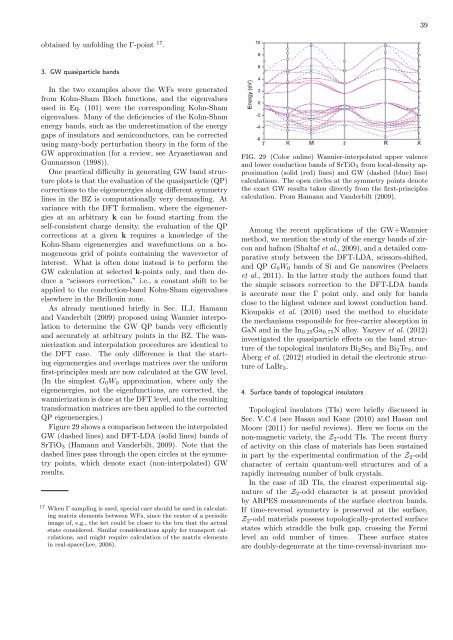Maximally localized Wannier functions: Theory and applications
Maximally localized Wannier functions: Theory and applications
Maximally localized Wannier functions: Theory and applications
Create successful ePaper yourself
Turn your PDF publications into a flip-book with our unique Google optimized e-Paper software.
39<br />
obtained by unfolding the Γ-point 17 .<br />
3. GW quasiparticle b<strong>and</strong>s<br />
In the two examples above the WFs were generated<br />
from Kohn-Sham Bloch <strong>functions</strong>, <strong>and</strong> the eigenvalues<br />
used in Eq. (101) were the corresponding Kohn-Sham<br />
eigenvalues. Many of the deficiencies of the Kohn-Sham<br />
energy b<strong>and</strong>s, such as the underestimation of the energy<br />
gaps of insulators <strong>and</strong> semiconductors, can be corrected<br />
using many-body perturbation theory in the form of the<br />
GW approximation (for a review, see Aryasetiawan <strong>and</strong><br />
Gunnarsson (1998)).<br />
One practical difficulty in generating GW b<strong>and</strong> structure<br />
plots is that the evaluation of the quasiparticle (QP)<br />
corrections to the eigenenergies along different symmetry<br />
lines in the BZ is computationally very dem<strong>and</strong>ing. At<br />
variance with the DFT formalism, where the eigenenergies<br />
at an arbitrary k can be found starting from the<br />
self-consistent charge density, the evaluation of the QP<br />
corrections at a given k requires a knowledge of the<br />
Kohn-Sham eigenenergies <strong>and</strong> wave<strong>functions</strong> on a homogeneous<br />
grid of points containing the wavevector of<br />
interest. What is often done instead is to perform the<br />
GW calculation at selected k-points only, <strong>and</strong> then deduce<br />
a “scissors correction,” i.e., a constant shift to be<br />
applied to the conduction-b<strong>and</strong> Kohn-Sham eigenvalues<br />
elsewhere in the Brillouin zone.<br />
As already mentioned briefly in Sec. II.J, Hamann<br />
<strong>and</strong> V<strong>and</strong>erbilt (2009) proposed using <strong>Wannier</strong> interpolation<br />
to determine the GW QP b<strong>and</strong>s very efficiently<br />
<strong>and</strong> accurately at arbitrary points in the BZ. The wannierization<br />
<strong>and</strong> interpolation procedures are identical to<br />
the DFT case. The only difference is that the starting<br />
eigenenergies <strong>and</strong> overlaps matrices over the uniform<br />
first-principles mesh are now calculated at the GW level.<br />
(In the simplest G 0 W 0 approximation, where only the<br />
eigenenergies, not the eigen<strong>functions</strong>, are corrected, the<br />
wannierization is done at the DFT level, <strong>and</strong> the resulting<br />
transformation matrices are then applied to the corrected<br />
QP eigenenergies.)<br />
Figure 29 shows a comparison between the interpolated<br />
GW (dashed lines) <strong>and</strong> DFT-LDA (solid lines) b<strong>and</strong>s of<br />
SrTiO 3 (Hamann <strong>and</strong> V<strong>and</strong>erbilt, 2009). Note that the<br />
dashed lines pass through the open circles at the symmetry<br />
points, which denote exact (non-interpolated) GW<br />
results.<br />
17 When Γ sampling is used, special care should be used in calculating<br />
matrix elements between WFs, since the center of a periodic<br />
image of, e.g., the ket could be closer to the bra that the actual<br />
state considered. Similar considerations apply for transport calculations,<br />
<strong>and</strong> might require calculation of the matrix elements<br />
in real-space(Lee, 2006).<br />
FIG. 29 (Color online) <strong>Wannier</strong>-interpolated upper valence<br />
<strong>and</strong> lower conduction b<strong>and</strong>s of SrTiO 3 from local-density approximation<br />
(solid (red) lines) <strong>and</strong> GW (dashed (blue) line)<br />
calculations. The open circles at the symmetry points denote<br />
the exact GW results taken directly from the first-principles<br />
calculation. From Hamann <strong>and</strong> V<strong>and</strong>erbilt (2009).<br />
Among the recent <strong>applications</strong> of the GW+<strong>Wannier</strong><br />
method, we mention the study of the energy b<strong>and</strong>s of zircon<br />
<strong>and</strong> hafnon (Shaltaf et al., 2009), <strong>and</strong> a detailed comparative<br />
study between the DFT-LDA, scissors-shifted,<br />
<strong>and</strong> QP G 0 W 0 b<strong>and</strong>s of Si <strong>and</strong> Ge nanowires (Peelaers<br />
et al., 2011). In the latter study the authors found that<br />
the simple scissors correction to the DFT-LDA b<strong>and</strong>s<br />
is accurate near the Γ point only, <strong>and</strong> only for b<strong>and</strong>s<br />
close to the highest valence <strong>and</strong> lowest conduction b<strong>and</strong>.<br />
Kioupakis et al. (2010) used the method to elucidate<br />
the mechanisms responsible for free-carrier absorption in<br />
GaN <strong>and</strong> in the In 0.25 Ga 0.75 N alloy. Yazyev et al. (2012)<br />
investigated the quasiparticle effects on the b<strong>and</strong> structure<br />
of the topological insulators Bi 2 Se 3 <strong>and</strong> Bi 2 Te 3 , <strong>and</strong><br />
Åberg et al. (2012) studied in detail the electronic structure<br />
of LaBr 3 .<br />
4. Surface b<strong>and</strong>s of topological insulators<br />
Topological insulators (TIs) were briefly discussed in<br />
Sec. V.C.4 (see Hasan <strong>and</strong> Kane (2010) <strong>and</strong> Hasan <strong>and</strong><br />
Moore (2011) for useful reviews). Here we focus on the<br />
non-magnetic variety, the Z 2 -odd TIs. The recent flurry<br />
of activity on this class of materials has been sustained<br />
in part by the experimental confirmation of the Z 2 -odd<br />
character of certain quantum-well structures <strong>and</strong> of a<br />
rapidly increasing number of bulk crystals.<br />
In the case of 3D TIs, the clearest experimental signature<br />
of the Z 2 -odd character is at present provided<br />
by ARPES measurements of the surface electron b<strong>and</strong>s.<br />
If time-reversal symmetry is preserved at the surface,<br />
Z 2 -odd materials possess topologically-protected surface<br />
states which straddle the bulk gap, crossing the Fermi<br />
level an odd number of times. These surface states<br />
are doubly-degenerate at the time-reversal-invariant mo-













